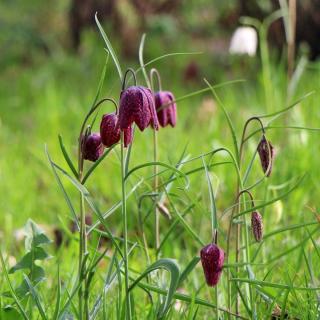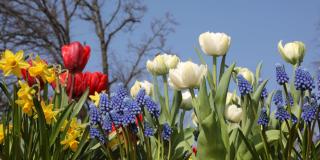

Hoping to feel the magic of Spring in the garden? Get ready for next year and dive into the fabulous world of bulb flowers.
Fall is the ideal time to plant these jewels. It’s an excellent activity to wrap up the year’s gardening tasks.
Bulb flowers will grace you with a magical feeling of joy. You plant them in Fall, and over the Winter they get ready to sprout and grow. Come Spring, they’re the highlight of the garden! Bulb flowers have a mesmerizing effect in every garden. While most shrubs and plants are still dormant, colored flowers pop out of the ground to trumpet the news that Spring is on its way. So what are you waiting for? Take part in this fairy tale and get started on the quest to plant a treasure trove of bulb flowers.

Now let’s explore uncharted territory. Are you familiar with the charming fritillary? The deep wine-colored flower will turn your garden into a miniature paradise.
Remember to check the romantic botanical tulip and pure snowdrop bloomers out, too. They’ll invite you to a miniature world of magic.
Turn the chore of planting into an unforgettable moment. Fall is a wonderful time to get down to business with nature. Of course, it’s a joy to do so on your own, but it’s also much funner when children, friends and family are involved! Not only is it a nice way to get things done together, but at every stage of the growing and blooming, those precious moments will come back and comfort you.
So gather ’round and sweep those dead leaves aside to make way for the digging of the future treasure’s hiding place. 5 steps to get this done:
Step 1:
Remove weeds and small rocks, and then mix a little fresh soil mix into the ground soil. This helps increase drainage.
Step 2:
Dig shallow holes in the ground. You can either make them a bit wide to plant large clusters of bulbs, or make them just large enough to accommodate one or two bulbs only. The size of the bulb itself is what determines the planting depth. Large bulbs (2 inches / 5 cm and over) need a depth of 6 inches (15 cm). Smaller bulbs (1 to 2 inches or 2.5 to 5 cm), on the other hand, only require a hole 3 to 4 inches deep (7 to 10 cm).
Step 3:

Step 4:
Backfill the hole with any left-over garden soil.
Step 5:
If the soil is dry, pour a little water over the hole.